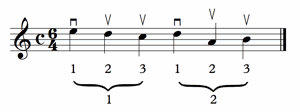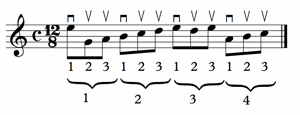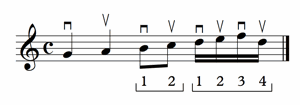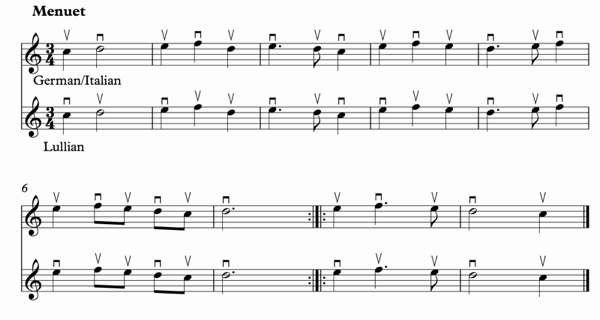A Timeline history of the Violin Bow - from c. 1600 - 1800
... the sources in detail ...
Georg Muffat (1653 - 1704)
Florilegium Secundum (Passau, 1698)
Georg Muffat was one of the most significant performers, composers and writers of the late 17th century. He studied (almost certainly) with Lully, he knew Corelli, his ensemble pieces for strings embrace French and Italian styles, and he was particularly concerned with educating German musicians how to play in the appropriate style.
He wrote two collections of dance suites in the French style for ensemble - Florilegium Primum (1695) and Florilegium Secundum (1698). In the Preface to each he gives a few guidelines to how they should be performed. And in particular, the Preface to Florilegium Secundum is a treasure-trove of extremely detailed and precise information covering a wide range of topics - fingering, bowing, tempo, Lullian practice and ornamentation, which he beautifully presents with this little couplet:
While the entire Preface is pretty much obligatory reading for all baroque musicians, our focus in this context is his second category - Bowing. Rather to my surprise, the text is not easily available on the internet, so, well, here it is.
The Use of the Bow
He wrote two collections of dance suites in the French style for ensemble - Florilegium Primum (1695) and Florilegium Secundum (1698). In the Preface to each he gives a few guidelines to how they should be performed. And in particular, the Preface to Florilegium Secundum is a treasure-trove of extremely detailed and precise information covering a wide range of topics - fingering, bowing, tempo, Lullian practice and ornamentation, which he beautifully presents with this little couplet:
"Fingering, Bowing, Tempo, Style and Charm
Make the violin lively and lovely-sounding".
Make the violin lively and lovely-sounding".
While the entire Preface is pretty much obligatory reading for all baroque musicians, our focus in this context is his second category - Bowing. Rather to my surprise, the text is not easily available on the internet, so, well, here it is.
The Use of the Bow
The majority of German violinists and other players of upper string instruments hold the bow as the French [Lullists] do, pressing the hair with the thumb and resting the other fingers on the stick of the bow; the French hold it the same way when playing the bass. The Italians, among others, differ in playing these upper instruments in that they never touch the hair; and gambists and other bass-players differ in that they place their fingers between the hair and wood of the bow.
I think we can take this to mean that while the French hold the bow with the thumb under the frog, the Italians hold it with the thumb on the stick. Certainly also lines up with what we have read elsewhere.
Moreover ... all the finest masters, regardless of their nationality, agree with each other that the longer, steadier, sweeter, and more even the bow-stroke is, the finer it is considered;...
Again, this confirms what other writers - from Rognoni on - have written.
He then points out:
However, it is well known that the Lullists, whom the French, the
English, those from the Low Countries, and many others follow, all observe an identical way of bowing, even if a thousand of them play
together. They all observe the same way of playing the principal notes in the measure: above all, those that begin the measure, those that define the cadence, and those that most clearly emphasise the dance rhythm.
This uniformity, so necessary for marking the dance-movement, is
not found among our players in Germany, regardless of their excellence. Many gentlemen, on their return from foreign parts, have remarked that such a great difference in sound was often astonishing and that the dances were considerably altered. To obviate this disorder and danger of confusion, I have thought to please the curious by remembering here certain of the principal rules of the French method of bowing. The mark  placed over a note signifies down-bow, and the mark
placed over a note signifies down-bow, and the mark  up-bow.
up-bow.
1. The first note in each bar, where there is no rest or breath, should be played down-bow, regardless of its value. This is the principal and almost indispensable rule of the Lullists, on which almost the entire secret of bowing depends, and which differentiates them from the others. All subsequent rules depend on this rule. In order to know how the other notes fall into place and are to be played, one must attend to the following rules.
2. In common time, which the theorists call "tempus imperfectum", the measure is divided equally in half. Notes on odd parts of the measure (1, 3, 5, etc.) are played down-bow, and those on even parts (2, 4, 6, etc.) should be played up-bow.

The rule applies also in triple meter, or any meter where the beats are diminished equally in half. I call diminutions all those notes that are faster than those values indicated in the time signature.

This way of counting equal divisions of beats is similarly observed if rests of the same value appear instead of notes.

All the finest masters agree readily with the French on this second rule.
3. Since, according to the first rule, the first note in the bar is down-bow, the second of three equal notes (which comprise a complete bar in triple time) is always up-bow, and the third is once again down-bow, at least when one plays rather slowly; therefore in beginning the following bar, one must play down-bow for the second time in succession.

More often, however, the second and third notes are played in the same up-bow stroke, divided distinctly in two. This is called craquer. It allows one to play a little faster with greater ease.

4. In Proportione Sextupla 6/4 the bar is divided into two basic parts.

In Proportione Nonupla 9/8 the bar is divided into three parts.

In Proportione Duodecupla [ 12/8] the bar is divided into four parts.

In these distributions, each part contains three of those values indicated in the time signature. The first of the three equal notes is almost always played down-bow, for a clearer sound, even if the group does not begin the bar, and the two others are played in an up-bow stroke, divided in two. If there is a rest instead of the first note, the following note should unquestionably be played down-bow.

5. When several notes, each of one measure duration, appear in succession, each should be down-bow.

In six, or in twelve, several successive notes of equal value should be played alternately down-bow and up-bow according to whether they fall on an odd or even note, as explained in the second rule;

but in nine, they follow the first aspect of the third rule (triple meter).

6. Several equal successive syncopated notes usually require down-bow and up-bow alternatively. We are concerned here with equal notes.

7. As far as mixed note-values are concerned, the first of the smaller values following longer values should be counted the odd number, so that it can be played down-bow, if it should come out that way,

or divided up-bow, if it should occur this way:

The first two beats of smaller value are played with divided played up-bows:

If other smaller values follow after that, they are played up-bow and down-bow alternately. As far as pauses and rests are concerned, they can be counted as notes.

8. When subdivisions of the bar consist of three notes, and the first has a dot after it, it is ordinarily down-bow.

9. Several successive notes, each completing the bar (or sub-division) after a pause or rest, should be down-bow and up-bow alternately regardless of the said rest or pause.

10. The little note by itself before the beginning of the bar (a) as well as the one that passes quickly after a dot or after a short rest (b) and likewise the smaller note that follows a larger syncopated one (c) should always be up-bow.

If the longer syncopated note is also up-bow, it will be necessary to divide the up-bow stroke in half, thereby adding the following note to it (indicated by *).

Because of the rapid tempo of Courantes, those notes that begin each even-numbered bar (interpreting this type of piece as triple meter) can occasionally be exempted from Rule 1 and, if so desired, can sometimes be played up-bow for better effect and greater ease; whereas those that begin the odd bars and thus emphasise the dance rhythm all the more are always played down-bow. Therefore it happens in the above-mentioned Courantes that not every beat but every alternate beat should be emphasised.

This is why in dances liked the Courante, not one, but two bars are shown together. Other than that, the first rule concerning the first note in the beat is always observed rigorously; as for other notes that begin a subdivision, either in regard to small remaining parts of beats in gigues, canaries, or other similar cases, because of their speed, it is often necessary to rely on the specifications of the fourth, eighth, and tenth rules. The next example shows what is to be done when frequent dots are intermingled with the notes.

Similarly, for speed, one must often countermand the eighth rule in Bourées and other similar airs, which are unhesitatingly bowed according to the next example, always allowing the first rule to take precedence. In these last three examples I have indicated this liberty with an asterisk (*).

Finally, when two little notes such as two sixteenth notes are joined to some other note purely as an ornament, they are sometimes played separately,

or sometimes for greater sweetness they are joined with the preceding note in one stroke or two.

It is clearly being false to the Lullian method to play the first note of a measure up-bow, but among the Germans and Italians this often occurs in triple meter, particularly when the first note is shorter than the second. Out of this divergence of opinion and this transgression of the aforesaid first rule arises a very great difference in bowing, which affects the execution of the stated first notes as much as those following and dependent on them. To make this diversity better understood, I have indicated the same series of notes played in two styles: that known to some Germans and Italians, and that according to the French method.

Slurring the little note after a dot or short rest to the following note in the same bow-stroke, breaking Rule 10, contradicts the liveliness of the music;

According to the French stye it should be played as follows;

However, on the contrary, it would be permissible, if the occasion called for it, to join the aforesaid little note to the preceding one "en craquant."

These are the essential rules of the Lullian bowing method, which are usually followed rigorously and uniformly in the upper part, the inner parts, and also in the bass. Despite so many repeated down-bows, one hears at no time anything disagreeable or harsh, but on the contrary, a marvelous coordination at great speed and in long bow-strokes, in an admirable steadiness of beat in the dance movements and in a diversity of tempos, in tender charm, and in vivacious playing. All of this is the great excellence of the true Lullists.
 placed over a note signifies down-bow, and the mark
placed over a note signifies down-bow, and the mark  up-bow.
up-bow. 1. The first note in each bar, where there is no rest or breath, should be played down-bow, regardless of its value. This is the principal and almost indispensable rule of the Lullists, on which almost the entire secret of bowing depends, and which differentiates them from the others. All subsequent rules depend on this rule. In order to know how the other notes fall into place and are to be played, one must attend to the following rules.
2. In common time, which the theorists call "tempus imperfectum", the measure is divided equally in half. Notes on odd parts of the measure (1, 3, 5, etc.) are played down-bow, and those on even parts (2, 4, 6, etc.) should be played up-bow.

The rule applies also in triple meter, or any meter where the beats are diminished equally in half. I call diminutions all those notes that are faster than those values indicated in the time signature.

This way of counting equal divisions of beats is similarly observed if rests of the same value appear instead of notes.

All the finest masters agree readily with the French on this second rule.
3. Since, according to the first rule, the first note in the bar is down-bow, the second of three equal notes (which comprise a complete bar in triple time) is always up-bow, and the third is once again down-bow, at least when one plays rather slowly; therefore in beginning the following bar, one must play down-bow for the second time in succession.

More often, however, the second and third notes are played in the same up-bow stroke, divided distinctly in two. This is called craquer. It allows one to play a little faster with greater ease.

4. In Proportione Sextupla 6/4 the bar is divided into two basic parts.

In Proportione Nonupla 9/8 the bar is divided into three parts.

In Proportione Duodecupla [ 12/8] the bar is divided into four parts.

In these distributions, each part contains three of those values indicated in the time signature. The first of the three equal notes is almost always played down-bow, for a clearer sound, even if the group does not begin the bar, and the two others are played in an up-bow stroke, divided in two. If there is a rest instead of the first note, the following note should unquestionably be played down-bow.

5. When several notes, each of one measure duration, appear in succession, each should be down-bow.

In six, or in twelve, several successive notes of equal value should be played alternately down-bow and up-bow according to whether they fall on an odd or even note, as explained in the second rule;

but in nine, they follow the first aspect of the third rule (triple meter).

6. Several equal successive syncopated notes usually require down-bow and up-bow alternatively. We are concerned here with equal notes.

7. As far as mixed note-values are concerned, the first of the smaller values following longer values should be counted the odd number, so that it can be played down-bow, if it should come out that way,

or divided up-bow, if it should occur this way:

The first two beats of smaller value are played with divided played up-bows:

If other smaller values follow after that, they are played up-bow and down-bow alternately. As far as pauses and rests are concerned, they can be counted as notes.

8. When subdivisions of the bar consist of three notes, and the first has a dot after it, it is ordinarily down-bow.

9. Several successive notes, each completing the bar (or sub-division) after a pause or rest, should be down-bow and up-bow alternately regardless of the said rest or pause.

10. The little note by itself before the beginning of the bar (a) as well as the one that passes quickly after a dot or after a short rest (b) and likewise the smaller note that follows a larger syncopated one (c) should always be up-bow.

If the longer syncopated note is also up-bow, it will be necessary to divide the up-bow stroke in half, thereby adding the following note to it (indicated by *).

Because of the rapid tempo of Courantes, those notes that begin each even-numbered bar (interpreting this type of piece as triple meter) can occasionally be exempted from Rule 1 and, if so desired, can sometimes be played up-bow for better effect and greater ease; whereas those that begin the odd bars and thus emphasise the dance rhythm all the more are always played down-bow. Therefore it happens in the above-mentioned Courantes that not every beat but every alternate beat should be emphasised.

This is why in dances liked the Courante, not one, but two bars are shown together. Other than that, the first rule concerning the first note in the beat is always observed rigorously; as for other notes that begin a subdivision, either in regard to small remaining parts of beats in gigues, canaries, or other similar cases, because of their speed, it is often necessary to rely on the specifications of the fourth, eighth, and tenth rules. The next example shows what is to be done when frequent dots are intermingled with the notes.

Similarly, for speed, one must often countermand the eighth rule in Bourées and other similar airs, which are unhesitatingly bowed according to the next example, always allowing the first rule to take precedence. In these last three examples I have indicated this liberty with an asterisk (*).

Finally, when two little notes such as two sixteenth notes are joined to some other note purely as an ornament, they are sometimes played separately,

or sometimes for greater sweetness they are joined with the preceding note in one stroke or two.

It is clearly being false to the Lullian method to play the first note of a measure up-bow, but among the Germans and Italians this often occurs in triple meter, particularly when the first note is shorter than the second. Out of this divergence of opinion and this transgression of the aforesaid first rule arises a very great difference in bowing, which affects the execution of the stated first notes as much as those following and dependent on them. To make this diversity better understood, I have indicated the same series of notes played in two styles: that known to some Germans and Italians, and that according to the French method.

Slurring the little note after a dot or short rest to the following note in the same bow-stroke, breaking Rule 10, contradicts the liveliness of the music;

According to the French stye it should be played as follows;

However, on the contrary, it would be permissible, if the occasion called for it, to join the aforesaid little note to the preceding one "en craquant."

These are the essential rules of the Lullian bowing method, which are usually followed rigorously and uniformly in the upper part, the inner parts, and also in the bass. Despite so many repeated down-bows, one hears at no time anything disagreeable or harsh, but on the contrary, a marvelous coordination at great speed and in long bow-strokes, in an admirable steadiness of beat in the dance movements and in a diversity of tempos, in tender charm, and in vivacious playing. All of this is the great excellence of the true Lullists.